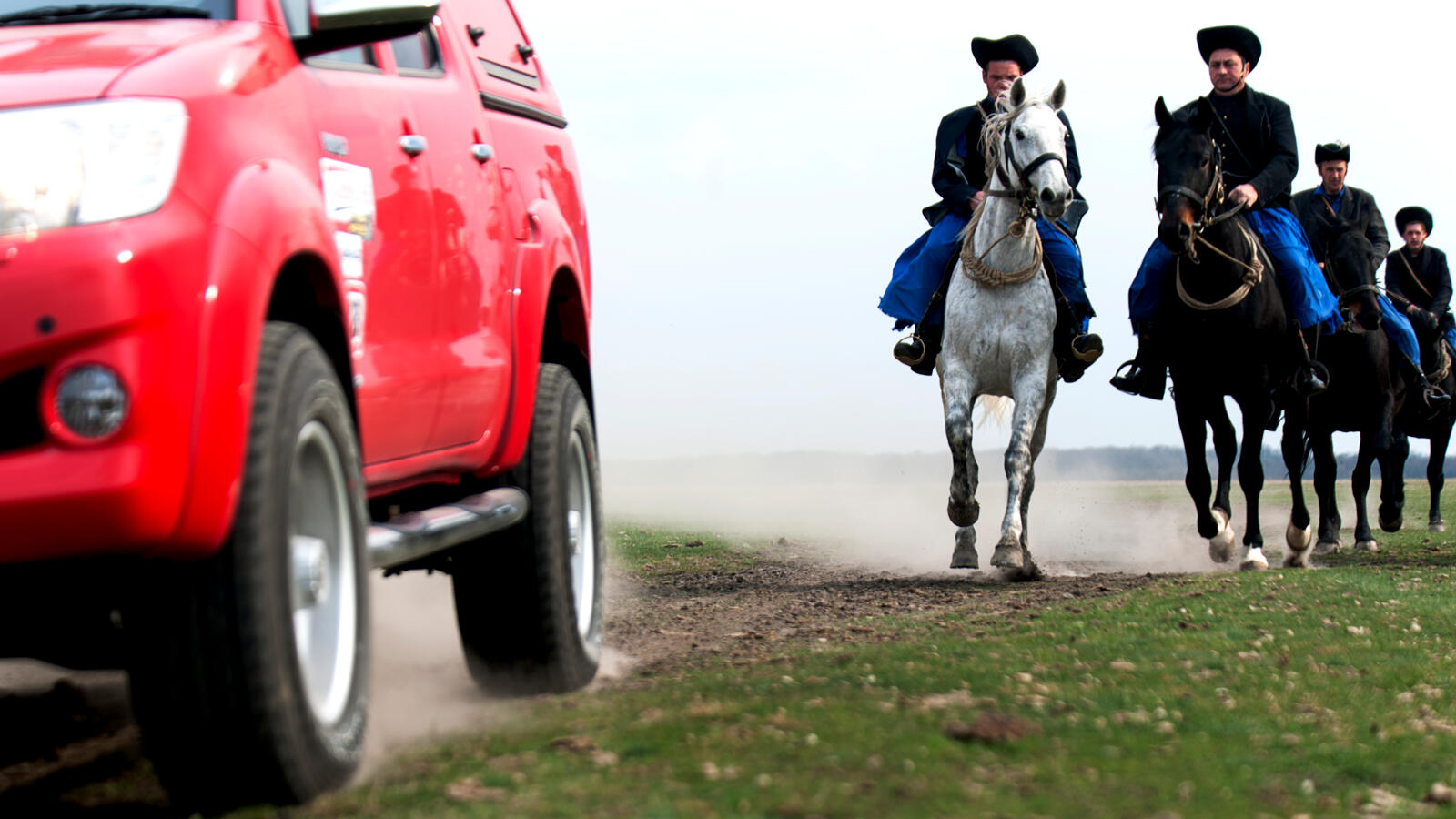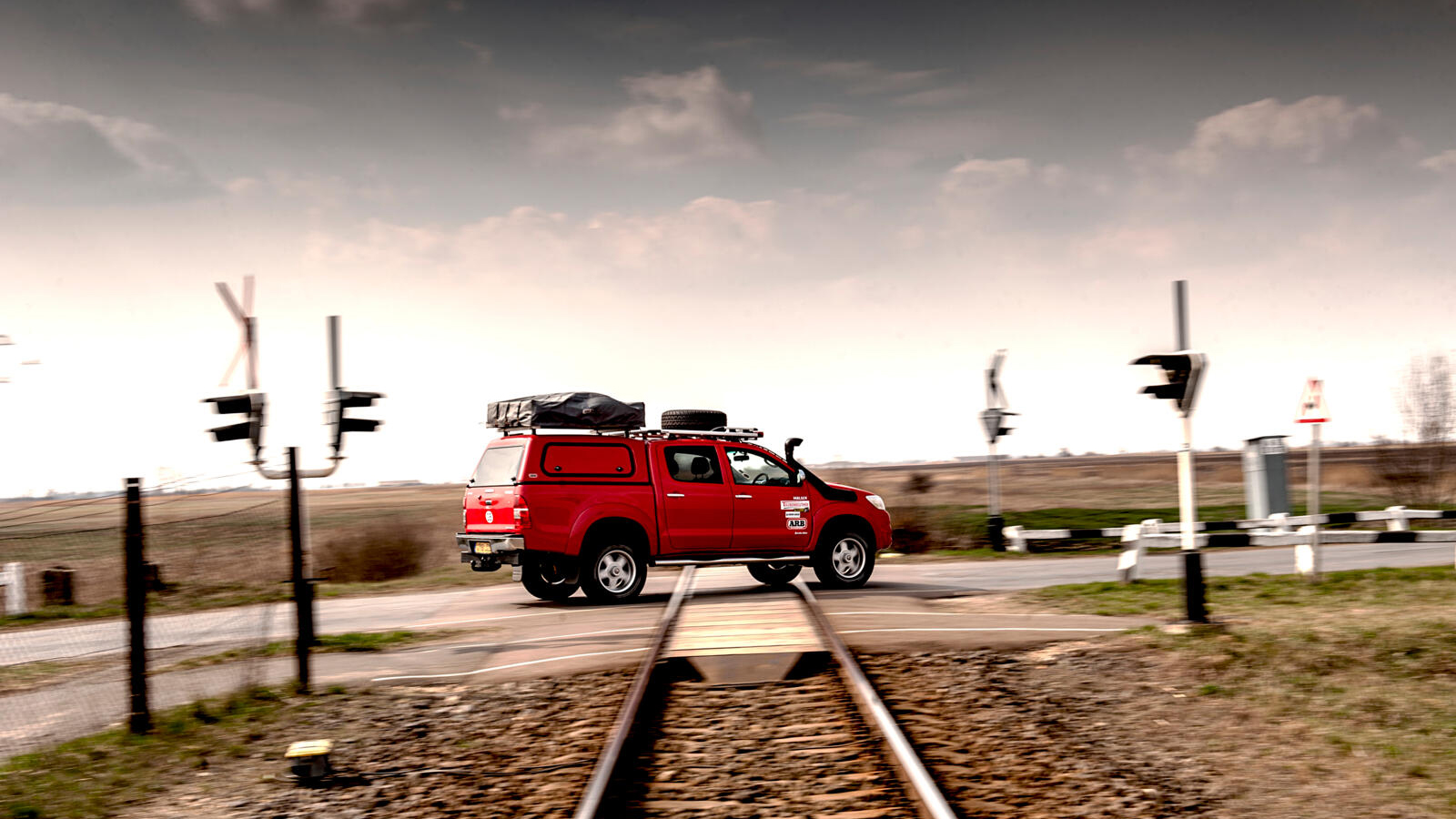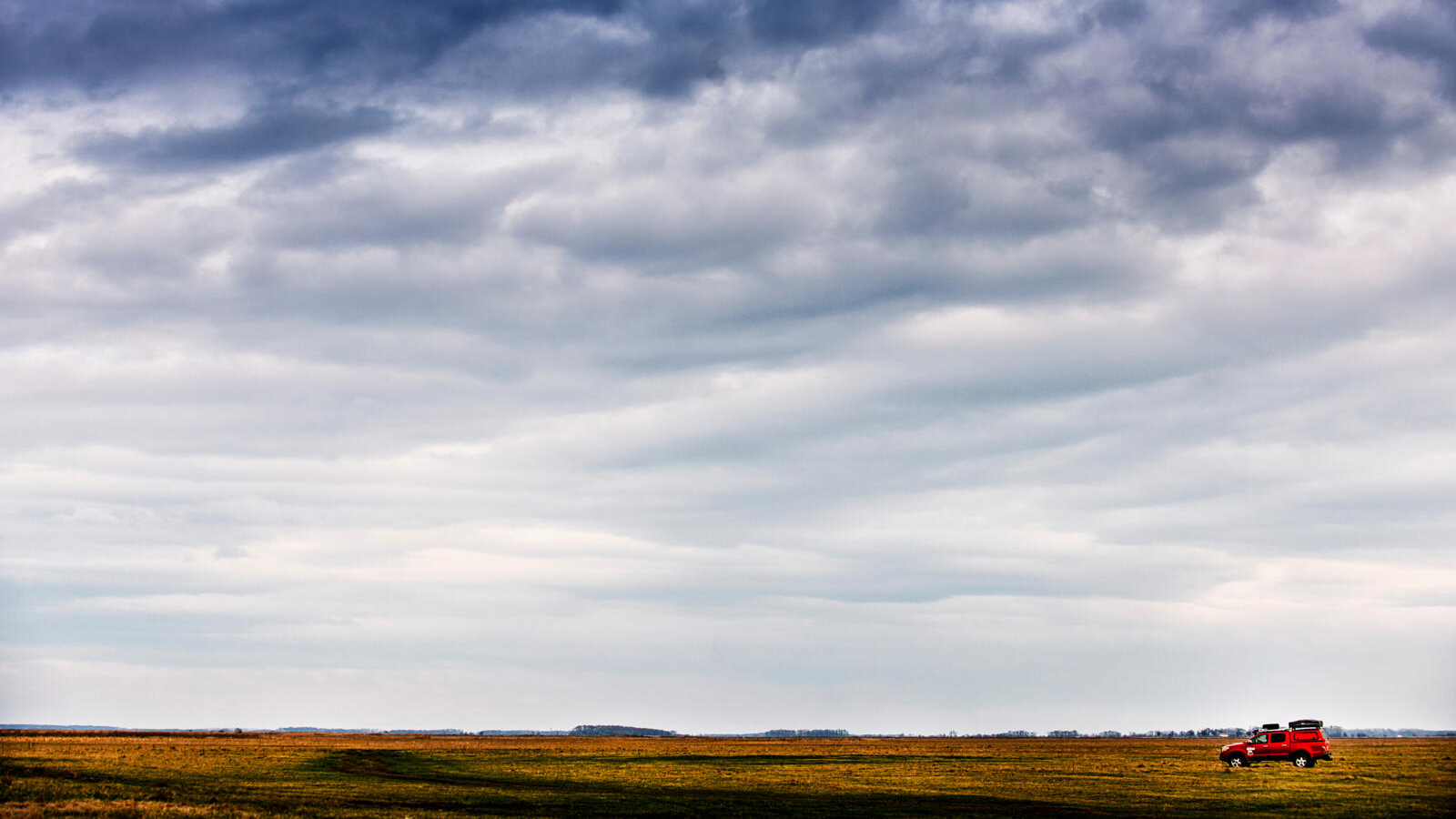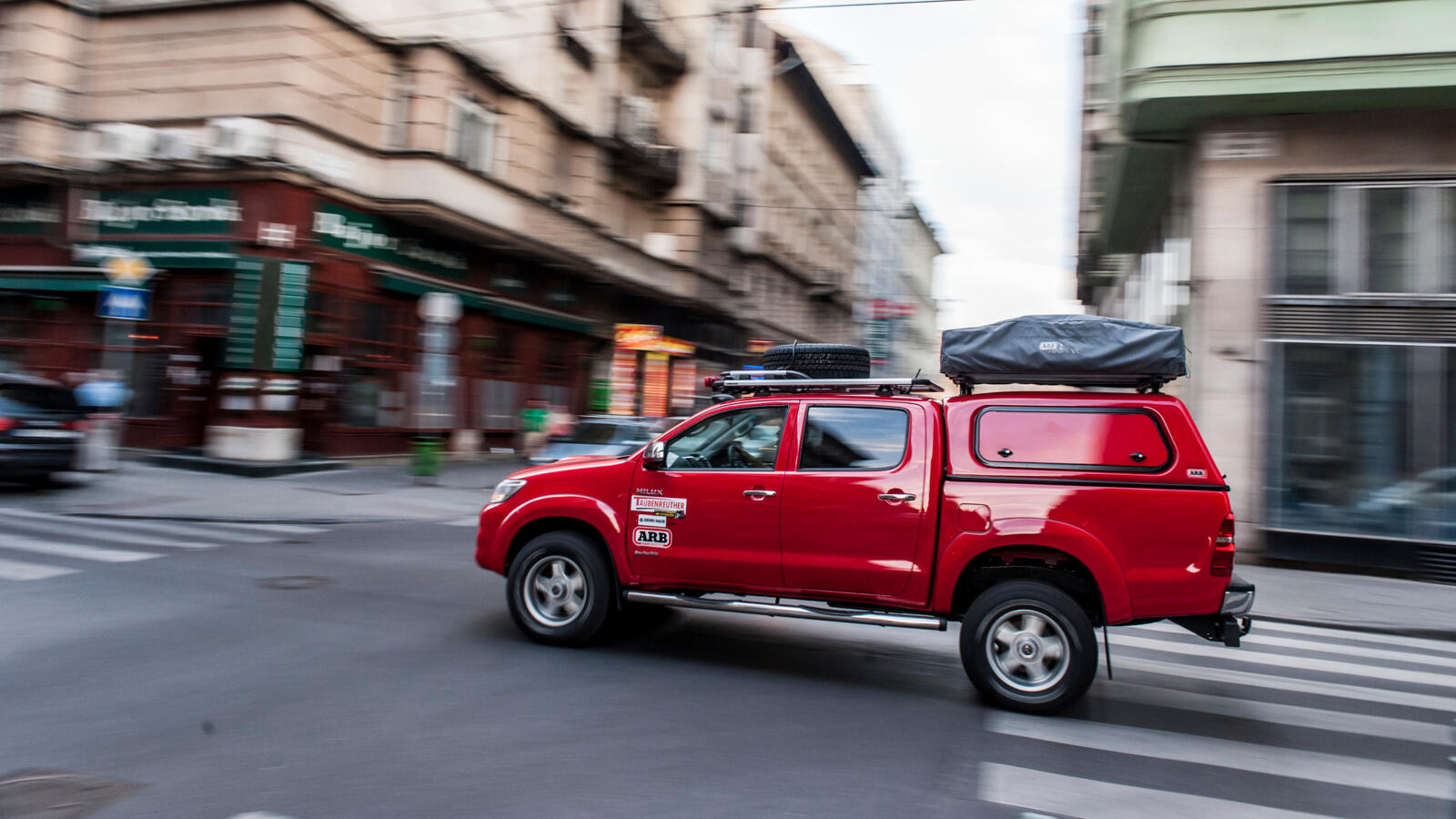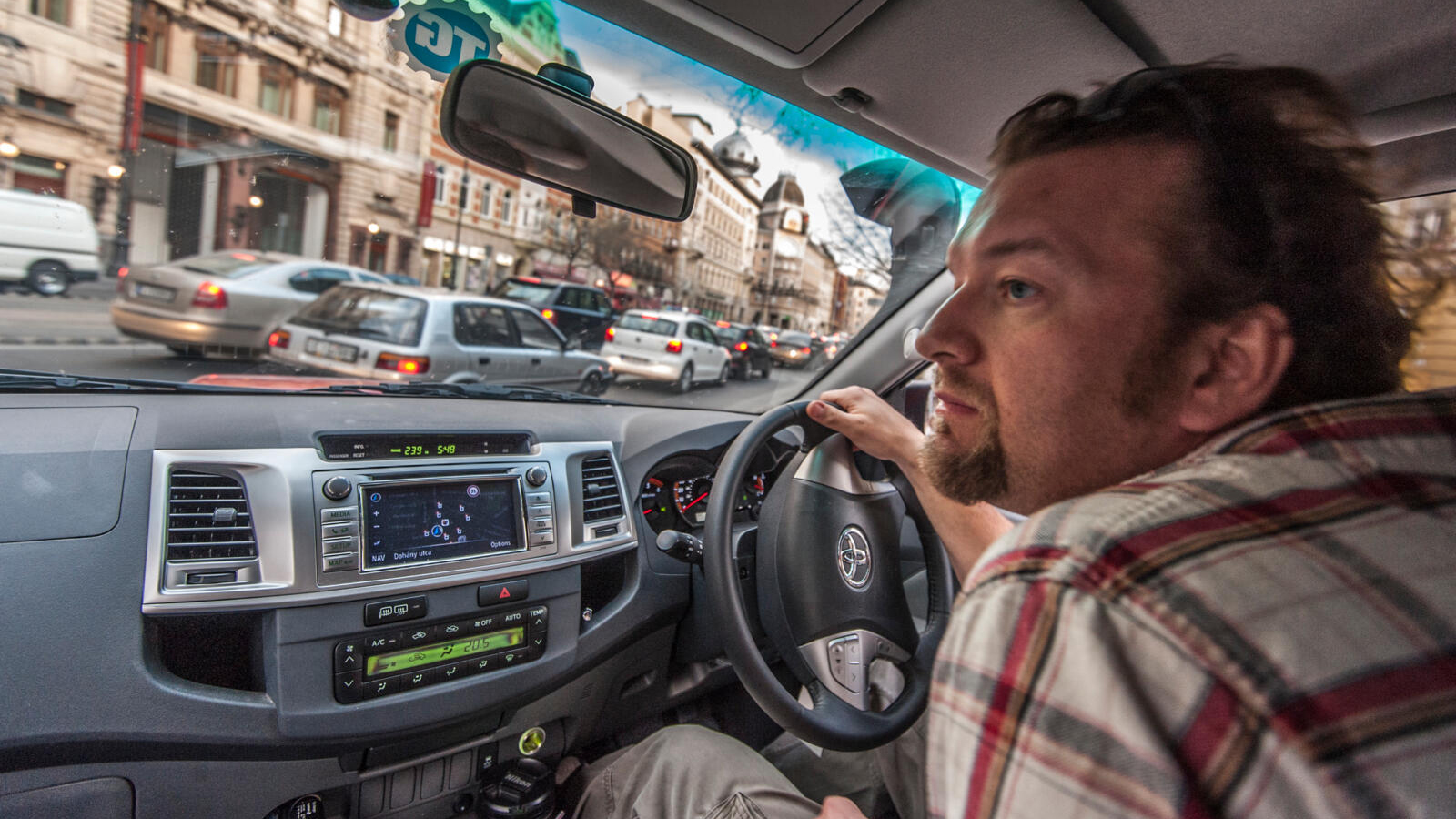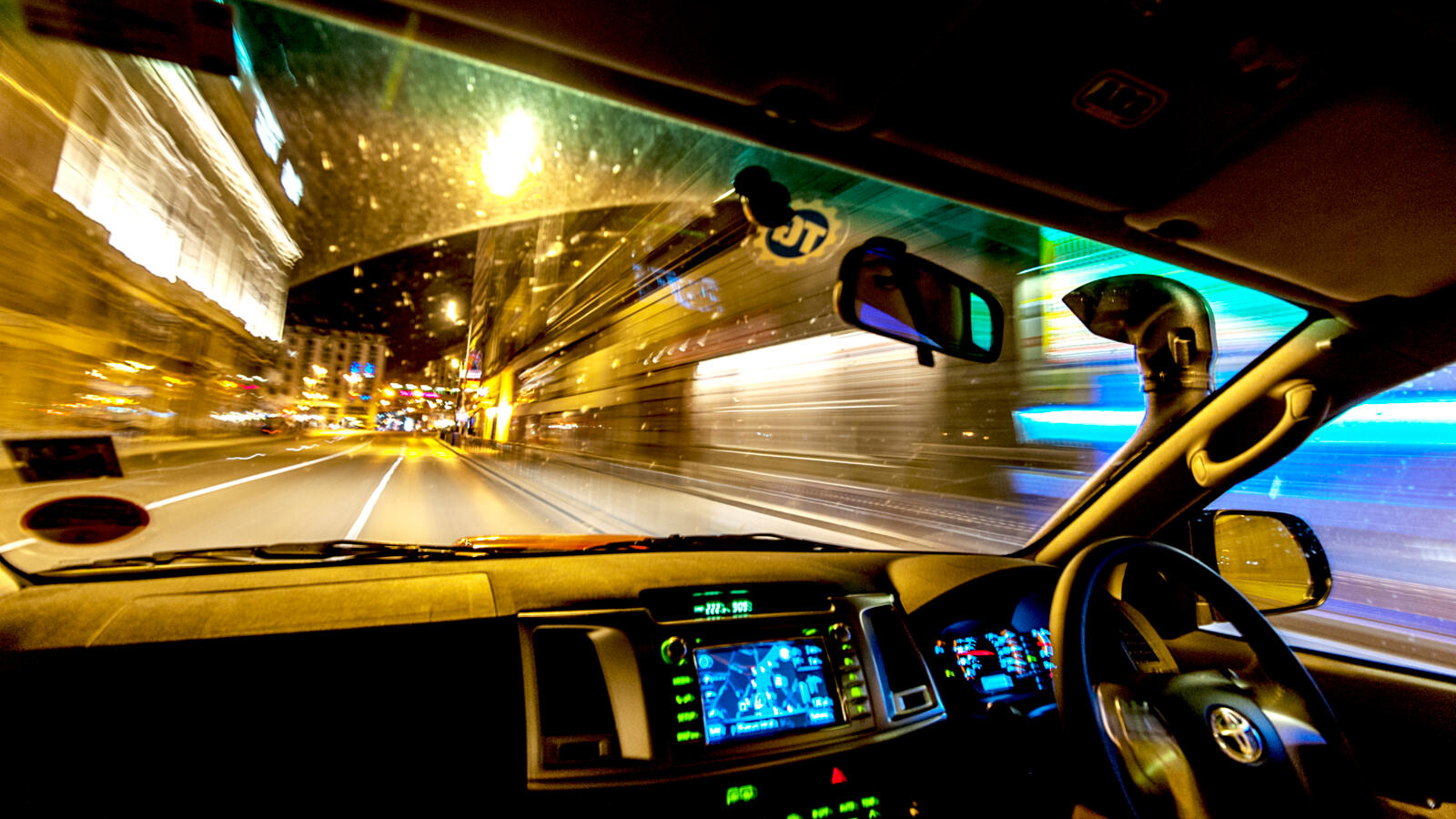
From the archives: Cowboys, Aliens and a Toyota Hilux
The old meets the new, as Hungarian herdsmen confront TG’s heavily-modded Hilux
This feature was originally published in the June 2012 issue of Top Gear magazine
There are five csikósok galloping alongside my gently bumping Toyota Hilux, dressed in stiff- looking black shirts and high-necked tunics, bright black riding boots and wide split-skirted trousers fashioned from bolts of the brightest azure blue. They wear black felt hats with upturned brims, like windblown Stetsons, loops of bullwhip coiled snugly left-to-right against their chests and tight expressions. The horses sport a braided lasso wound around their necks, and have no girth straps to secure their saddles, so the men ride splay-footed, centaurish and uncanny, even as we lope across the Puszta, smoke-like dust curling away behind as if the horse’s hooves are smouldering. It looks like a song and feels like a poem. pity then, that I’m a car writer, and spend the time subconsciously assessing damping. Sorry.
The Puszta itself is known by many names, translating literally as ‘the bare’ or ‘the empty’, but essentially it’s the westernmost of the Eurasian steppes, known variously as the Alföld, the Pannonian Steppe or simply the Great Hungarian Plain. Which loads it with epic-sounding potential. But the easiest way to describe this bit, near the Hortobágy National Park, is a kind of super-sized fen, a seemingly endless monotony of scruffy-bladed, coarse grass and thin stands of trees. The horizon is almost desert boundless, the sky an inscrutable grey, the scene snatched from a history book. Except for the fact that I’m charging about in a bright red truck with a tent on the roof, a blemish of modernity on the face of the ancient lie. Suddenly, I’m hit by a rather obvious thought: I have never done anything like this.
Mind you, up until this week, I’d never slept on a truck in the middle of nowhere, drunk home-brew pálinka, been carjacked, or lightly punched a horse. It’s been a big week.
A week based on rumour, gossip and a couple of vague Wiki entries about European cowboys. Which seemed like as good an excuse as any to figure out whether there are still big adventures to be had in little Europe. Whether you can truly get somewhere properly strange in a few days of driving, and feel like an alien without having to sweat it out on a long-haul flight. Turns out you can, but more of that in a bit.
Still, for the moment, we are simply a pointlessly robust snail wending across Europe, our house upon our back
It started with the usual boring trans-continental drawl: Lincolnshire to Folkestone to Calais, the mental anaesthetic of Belgium, a brief flash of the Netherlands – mildly lost – then into Germany and hauling south east. Co-pilot and photographer Justin had predictably instantly lost his phone, and, during his frantic root through the back of the Hilux just outside the Channel Tunnel, managed to leave the tailgate open. We drove the first 200 miles of mainland Europe basking in the incomprehensible flashing and waving that accompanies the celebrity of stupidity.
There were other initial issues. Despite kitting out the Toyota to conquer the Darién Gap (Old Man Emu suspension, Safari snorkel, underbody protection, wheels and Yokohama Geolandar tyres, winch, roof rack and ARB flip-out tent), I hadn’t packed a wheel brace. So despite having two full spares (one on the roof and one slung under the rear), we couldn’t actually amputate a defective tyre. The centre caps were also held on with small Allen key bolts, for which I didn’t have the Allen key. Also, I’d forgotten the jack. Still, with hope in our hearts and cheap truck-stop tools, we trundled across Europe, stopping wherever our requirements met with an adequate supply of mystery schnitzel. It is here that I realise that Justin snores. This is to become an issue.
Still, for the moment, we are simply a pointlessly robust snail wending across Europe, our house upon our back. The Hilux bellows its dieselly way along endless motorways, mpg down into the mid-teens (parachute of a roof arrangement), and thousands of miles pass beneath our gently humming wheels. It is a wonderful, if slightly uneventful, slog. Eventually we pass Vienna, skim the border of Slovakia – Bratislava definitely being the wrong way – and head towards Győr in Hungary. Which is where things start getting interesting.
We pause at the old Hegyeshalom checkpoint near Nickelsdorf. The border crossing became defunct in 2007 when Hungary and Slovakia joined the Schengen Agreement, but the Nickelsdorf side is interesting because it’s where the seams of the Iron Curtain started to unpick in ’89, the West and the Soviet Bloc starting to dissolve into one another. It’s an abandoned, depressing place, grey and sad. The security cameras still hang on the walls, broken and Eighties massive, the windows of the security block greasy with diesel and florid with graffiti. There are still morbid tangles of barbed wire in the grass. Somehow it manages to siphon joy, knowing why this place existed, and there’s a sense of foreboding in the air even as we leave. I don’t look back.
Top Gear
Newsletter
Thank you for subscribing to our newsletter. Look out for your regular round-up of news, reviews and offers in your inbox.
Get all the latest news, reviews and exclusives, direct to your inbox.
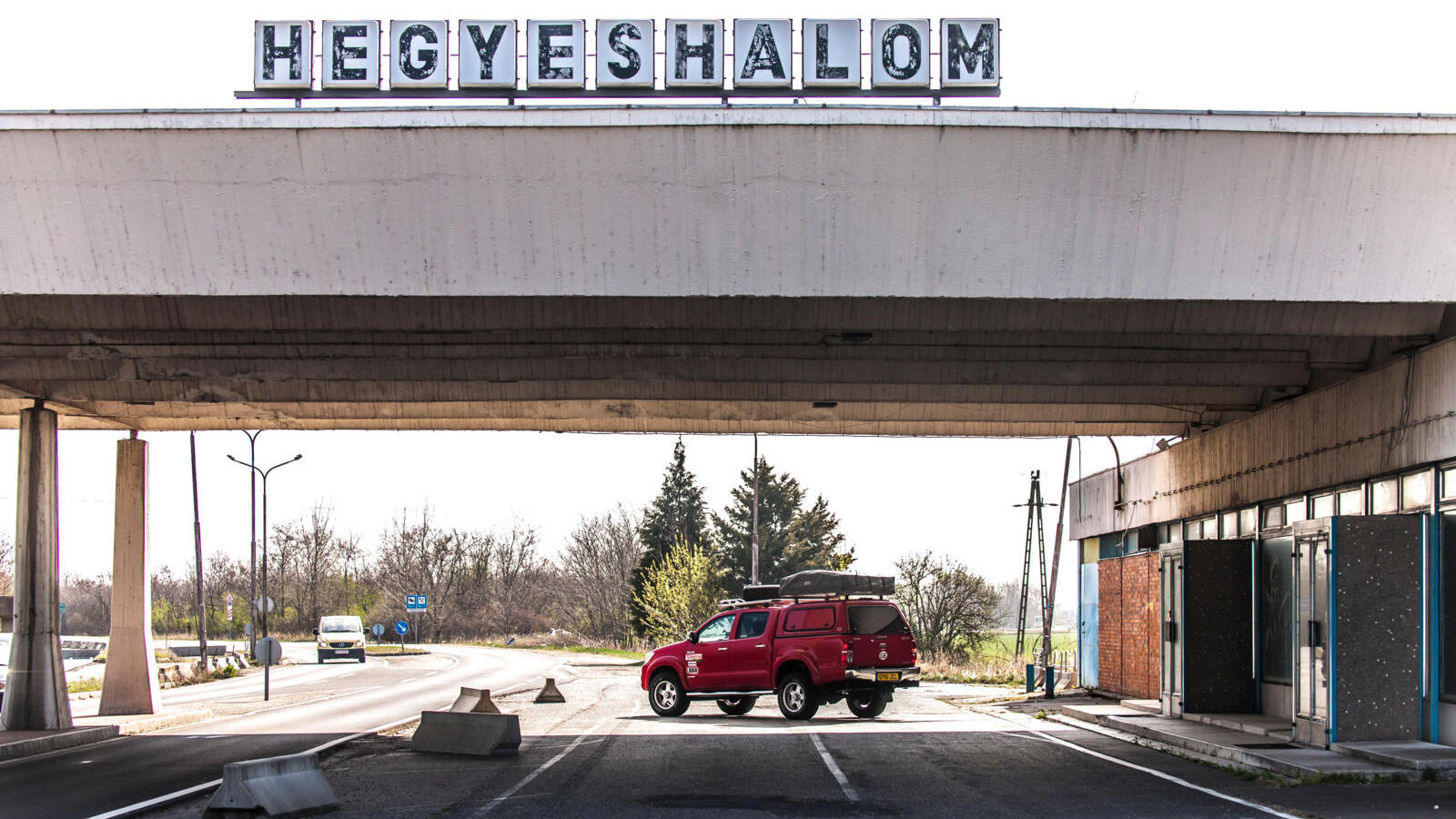
Funny that, because a couple of hours later, someone tries to carjack us. An old black BMW 5 Series suddenly appears in the wing mirrors, swerving wildly and flashing its lights, the men in the front pointing urgently. Being English, I immediately pull over, thinking that Justin has left the tailgate open again.
“What are you doing?” asks Justin, tightly.
“There are men. Pulling us over. There’s something wrong with the truck...” Justin scans the mirrors. “Is there something wrong with the truck? Can you see blue lights?” asks Justin. I wiggle the wheel experimentally and check for flashing strobes. “Er. No.”
“Then don’t stop. Don’t. F***ing. Stop.” Justin used to be a war photographer. He documented the Balkan conflict, the first Gulf War and the troubles in Northern Ireland. And, just for a second, he uses a tone of voice that punches me in the guts. I gun the truck, and pull off the shoulder. The Hilux suddenly seems very slow.
The BMW gives chase, and what follows is basically just a bit of swerving across a motorway, but feels more serious. I decide that if options become limited, then I will put the Hilux through the BMW, and am surprised to discover my willingness to do it. There’s a substantial WARN winch on our nose and a heavy-duty tow bar on the back. We weigh quite a lot. The concern is that they may be carrying guns. But you can’t fire a gun with an entire Toyota up your nose.
At the next junction or so, the BMW peels off, and we later learn that this is a common occurrence. Cars are taken at gunpoint on the motorway after being flagged down; by the time of rescue, the vehicle is across the Ukrainian border. We head towards Budapest, and I spend the next hours fitfully scanning the mirrors. Within 10 minutes, Justin is snoring. Again.
Budapest, as it turns out, is magnificent. A sprawling Baroque romance of a city, split into the twin urban sprawls of Buda and pest by the Danube, itself stitched together by a series of wildly different bridges. The metropolitan equivalent of what would happen if a sluttish Paris had an affair with London, Barcelona and Helsinki and produced a genetically impossible child. We eat chocolatey manna at the 150-year-old Gerbeaud confectioner’s, trundle past Europe’s largest synagogue, park the truck outside Parliament and meet an old lady who presses an ancient copy of Dostoyevsky’s Crime and Punishment into my hands and insists I take it ‘for karma’. I’m still not absolutely sure why. We find a hotel, somehow inveigle a 7ft Hilux into a 6ft 10in underground car park, meet with our translator/fixer/ miniature bodyguard Flora, and sleep.
Too little time is spent in Budapest. And then we’re marching east again, the wonderful Flora in tow – who happens to be the Chair of Amnesty International in Hungary, and therefore used to the inevitable abuse of human rights that involves spending any time in a car with Justin and me. The city becomes tempered by suburbs, petering out into lower-rises, and then, suddenly, the touch of humanity becomes lighter. And the horizons start to expand. Rural peters out into a barren swathe of not much. Roads slowly humble the further we venture, the Hilux revealing the benefit of the trade between refinement and ruggedness. We drive to the edge of the Puszta proper and meet a man whose land we will be exploring. He takes an immediate shine to Flora, displaying all the sexual subtlety of a man who works almost exclusively with horses, and leads us out into the scenic equivalent of extreme minimalism. It takes a while to recalibrate to a place whose colour palette seems to be stuck on a very low-res browny green.
It is here we see why Flora is invaluable; the local Magyar dialect sounds like someone trying to rap Finnish through a mouthful of marbles. I’m forced into the role of smiling imbecile as Flora negotiates the acquisition of a bottle of spirit and a place to camp. Still, we head out onto the steppe and drive for a while, the Hilux sinking gratefully into the bog-riddled grassland – this is what it was made for, and it likes it. We stop, because exploring the Puszta is literally aimless. This place is massive.
The spirit turns out to be home-made pálinka – a 56 per cent brandy with the scent of fruit and the taste of petrol. And it is just after a slug that I notice smoke on the horizon. Except it’s not smoke. It’s dust. The dust of csikósok horsemen, one of whom is riding five lashed-together mares standing on the rumps of the rearmost pair. I stare at the bottle accusingly. And feel instinctively like we should circle the wagons. A security measure rendered ineffective by only having one wagon to circle.
Before long, we’re trotting around the steppe suffused with wonder. Bullwhips are demonstrated, horsemanship deployed. If it weren’t for the Hilux, history would be raw and real. It gets more bizarre. While trying to have a three-way conversation with Flora and Lajos Garai (he of the fecund moustache), things get a bit mixed up and I assume that Lajos’ horse – the one cropping grass at my feet – is called Zoltán. While my attention is elsewhere, Zoltán decides to lift her head and bite my groin, which comes as a surprise, so I surreptitiously – and lightly – punch her in the nose. At which point, she bites my right thumb, and I start shouting at Zoltán the horse. Except Zoltán is stood behind me, is the man with the grey, and is now confused as to why I’m shouting his name, sucking my thumb and clutching my crotch.
Startled, the horsemen decide that they may be safer doing something practical, and launch into a demonstration of equestrianism you’re unlikely to see at Badminton. The historic reason for the lack of a girth is that back when there were wars fought across the Puszta by partisans, horsemen were denied the security of an understrap to make it harder to fire a gun from the saddle. Turning this measure into an advantage, locals trained their horses to sit and lie down on command – ostensibly to provide a fleshy windbreak on the notoriously gusty Puszta, but actually to provide a mobile shield, and to make them harder to spot from a distance. Horses were trained to remain prone even if a rider fired a rifle across its belly. The horsemen swivel their saddles off the horses as they sit or lie down like obedient labradors, staying passive even when a bullwhip is cracked inches from their head.
I sit on the roof rack, transfixed. But also a little out of sorts. The Hilux is the equivalent of turning up to the local swimming baths in full scuba gear. Out here, the csikósok make do with a knife and a lasso – we’ve turned up with a mobile outward-bound centre and a load of Tesco groceries. I am overdressed and yearning for simplicity. It doesn’t last long. When dusk shades the horizon, the horsemen decide that staying out on the Puszta is a little pointless. These days, they have homes to go to. I shake hands with each, pressing palms that feel like bags of warm walnuts, and realise with a little jolt that each of them has eyes of cobalt blue. And then they’re off, rewinding their arrival with dusty trails.
Filled with the spirit of wilderness adventure, we then head out to explore the night. Turns out that no matter how powerful your lights – and ours are powerful – when there are no landmarks by which to navigate, you get lost quickly, and then deeply nervous shortly after. Splashing through the odd ambush of scary axle-deep bog, up and over hillocks and random ditches, the Hilux just keeps on going. For which I am eminently thankful, because when you switch off the comforting rumble of the big 3.0-litre diesel, the utter silence on the Puszta is enough to still you. Quiet enough to make your ears ring with the clamour of nothing. And it’s a bit unnerving.
The Hilux, which seemed so out of place earlier on, suddenly feels like a refuge from the bigness of the Great Plain. It might not be the most sophisticated of machines, but during these last few days it has proved to be a strong, simple, solid place to anchor ourselves, both physically and psychologically. It may not really need the heavy duty suspension, the snorkel, the two spare wheels and an LED bar brighter than the actual sun, but when you’re several thousand miles from home, and too many hours from any sort of help, there is a comfort in the collateral of overkill. Eventually, we camp, and I spend a fractious night punching Justin in the kidneys to stop him snoring. It doesn’t work. The next day, we simply fold up the tent, have a quick wash in a frigid horse trough, shamble our way out of the Puszta for a few hours and point ourselves back home.
It’s not long before the virus of humanity comes crashing back into view, and I start to hunch my shoulders against it. After the Puszta, everything feels so very close. You realise how hemmed and huddled we humans like to be, channelled, stacked and slotted into the gaps between gaps. But after thrumming along in the Hilux for a while I realise that it doesn’t matter. Because having looked into the blue eyes of the csikósok, and breathing deep of the Puszta, I take comfort in the fact that there really are still great swathes of magic out there. And they’re much, much closer than you think.
Words: Tom Ford
Images: Justin Leighton
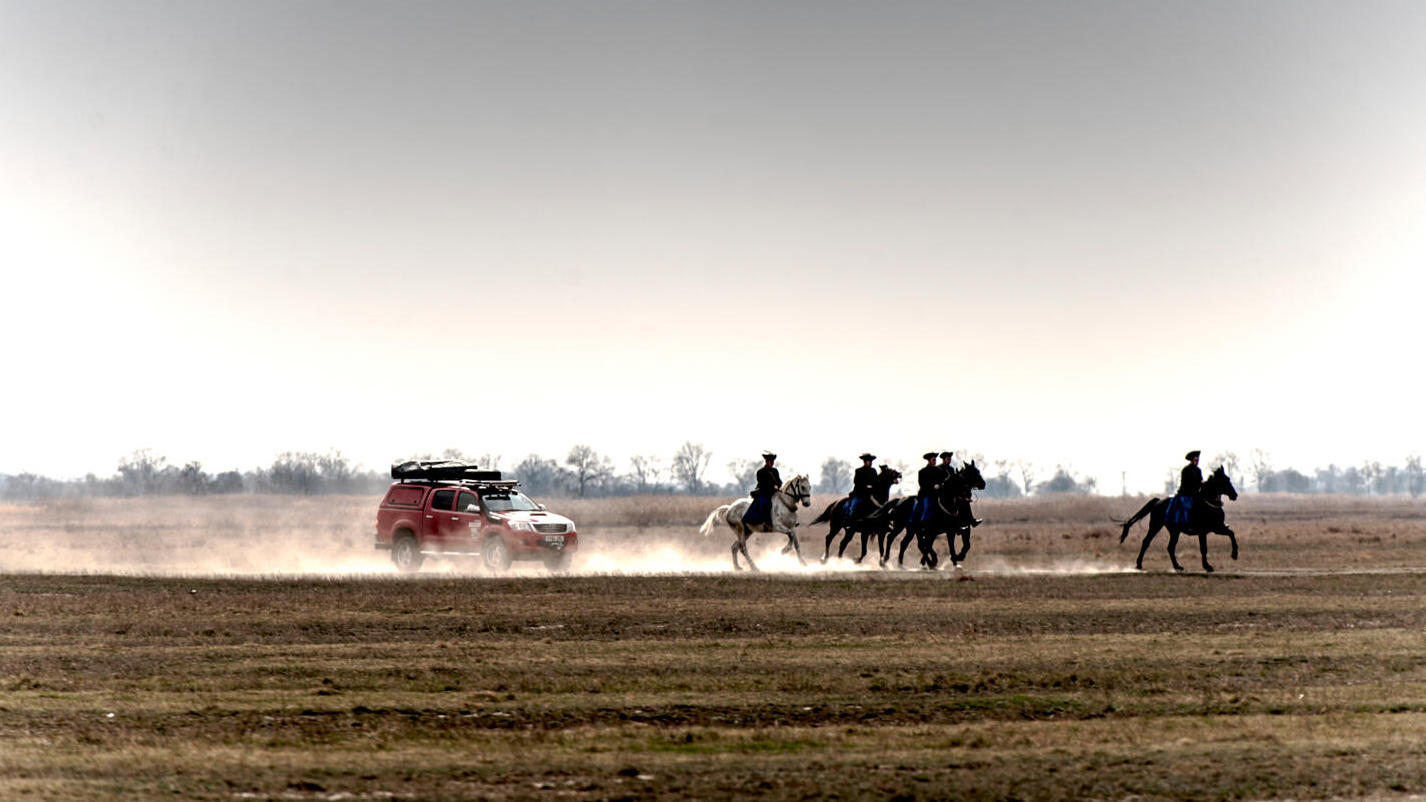
Trending this week
- Car Review
Porsche 911 GT3 (992.2)




